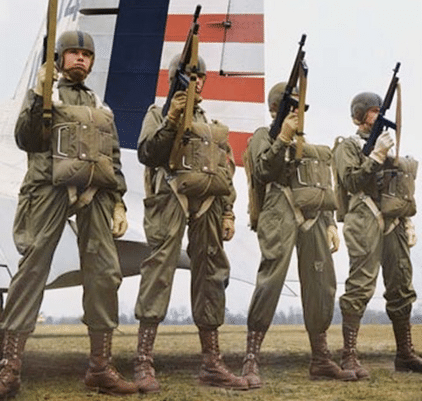In the late 1930s, several countries began experimenting with the use of airborne troops. The Soviet Union was the first to organize paratroop maneuvers in 1930-1935, demonstrating the effectiveness of these units for surprise operations and the capture of strategic points. Nazi Germany also developed its Fallschirmjäger, which were successfully used in 1940 for the invasion of the Netherlands and Crete in 1941. These successes did not go unnoticed by American strategists. In 1939, the US Army began considering the creation of its own airborne troops.
In June 1940, General George C. Marshall, Chief of Staff of the U.S. Army, authorized the study of setting up parachute units. On June 25, 1940, Major William C. Lee, an infantry officer with a passion for aviation and new warfare strategies, was appointed to oversee this research. He is sometimes referred to as the “Father of American Airborne Troops”.
On June 25, 1941, the 501st Parachute Infantry Battalion (PIB) was activated at Fort Benning, Georgia, officially marking the birth of the American parachute forces. This battalion served as the nucleus for the future expansion of the US Airborne.
Other units were soon created:
- The 502nd Parachute Infantry Battalion, activated in July 1941.
- The 503rd Parachute Infantry Regiment, formed in October 1941.
- In November 1941, Airborne Command was established under Major Lee to oversee the expansion of airborne troops.
The first units underwent rigorous training at Fort Benning, including airplane jumps, combat exercises and simulated airborne attacks.
The United States’ entry into the war following the attack on Pearl Harbor (December 7, 1941) accelerated the development of parachute units. In 1942, battalions became regiments, and regiments were integrated into airborne divisions:
- 82nd Airborne Division (created in August 1942): initially an infantry division, it became the US Army’s first airborne division.
- 101st Airborne Division (created August 1942): New division entirely dedicated to airborne operations.
- 17th, 11th and 13th Airborne Divisions formed in 1943.
American paratroopers take part in their first major assault during Operation Husky (July 1943) in Sicily. This first deployment was chaotic due to bad weather and airdrop errors, but it proved the usefulness of airborne units.
They went on to win worldwide recognition during the Normandy landings (June 6, 1944) with operations Overlord and Neptune, where the 101st and 82nd Airborne played a crucial role in capturing key positions before the main invasion.
The creation of the US Airborne in 1941 marked a revolution in the US Army. Inspired by foreign advances, developed under the supervision of William C. Lee, and honed by combat experience, it became one of the most feared forces of the Second World War.

